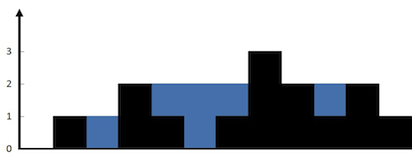标签:ret 表示 题目 turn 需要 tar 双向 png 双指针
给定 n 个非负整数表示每个宽度为 1 的柱子的高度图,计算按此排列的柱子,下雨之后能接多少雨水。
示例 1:

输入:height = [0,1,0,2,1,0,1,3,2,1,2,1]
输出:6
解释:上面是由数组 [0,1,0,2,1,0,1,3,2,1,2,1] 表示的高度图,在这种情况下,可以接 6 个单位的雨水(蓝色部分表示雨水)。
示例 2:
输入:height = [4,2,0,3,2,5]
输出:9
提示:
这种思路比较直观,每一个条形能注水的多少,取决于当前条形高度,以及左侧最高条形高度和右侧最高条形高度。
注意,如果每个条形都现场查找左右两侧最大高度,二层循环下的时间按复杂度是 O(N^2)。
我们可以使用数组保存两侧最高条形高度这个“状态值”,然后直接查表即可。
/*
* @lc app=leetcode id=42 lang=cpp
*
* [42] Trapping Rain Water
*/
// @lc code=start
class Solution {
public:
int trap(vector<int>& height) {
if (height.empty()) return 0;
int n = height.size();
vector<int> left_max(n), right_max(n);
left_max[0] = height[0];
for (int i = 1; i < n; i++) {
left_max[i] = max(height[i], left_max[i - 1]);
}
right_max[n - 1] = height[n - 1];
for (int i = n - 2; i >= 0; i--) {
right_max[i] = max(height[i], right_max[i + 1]);
}
int res = 0;
for (int i = 1; i < n - 1; i++) {
res += min(left_max[i], right_max[i]) - height[i];
}
return res;
}
};
// @lc code=end
同样是利用两侧最高条形来计算,另一种方法是我们不用单向扫描,而是改用双向扫描算法,也就是双指针的思路。我们从两端选取能确定蓄水量的条形,并向中间相向推进。
/*
* @lc app=leetcode id=42 lang=cpp
*
* [42] Trapping Rain Water
*/
// @lc code=start
class Solution {
public:
int trap(vector<int>& height) {
int left = 0, right = height.size() - 1;
int left_max = 0, right_max = 0;
int res = 0;
while (left < right) {
if (height[left] < height[right]) {
if (left_max <= height[left]) {
left_max = height[left];
} else {
res += (left_max - height[left]);
}
++left;
} else {
if (right_max <= height[right]) {
right_max = height[right];
} else {
res += (right_max - height[right]);
}
--right;
}
}
return res;
}
};
// @lc code=end
思路是这样的:我们不断增加新的条形,这样凹槽中的水位可能就要不断上涨。只需要计算出每次上涨的水量,并累加求和即可。
这种方案用的是单调栈。右边新增的条形更短,则入栈保存状态;新条形更长,则触发涨水条件,出栈计算水量。
/*
* @lc app=leetcode id=42 lang=cpp
*
* [42] Trapping Rain Water
*/
// @lc code=start
class Solution {
public:
int trap(vector<int>& height) {
int water = 0;
deque<int> q; // 单调队列,存下标
for (int i=0; i<height.size(); i++) {
// 比左边矮没事,比左边高就要涨水了
while (!q.empty() && height[i] > height[q.back()]) {
int low = height[q.back()]; // 原水位
q.pop_back();
if(!q.empty()) {
int w = i - q.back() - 1;
int h = min(height[i], height[q.back()]) - low; // 增加的水位高度
water += w * h;
} // 原栈顶决定了低水位,新栈顶和新条形决定了高水位和宽度
}
q.push_back(i);
}
return water;
}
};
// @lc code=end
标签:ret 表示 题目 turn 需要 tar 双向 png 双指针
原文地址:https://www.cnblogs.com/zhcpku/p/14450892.html